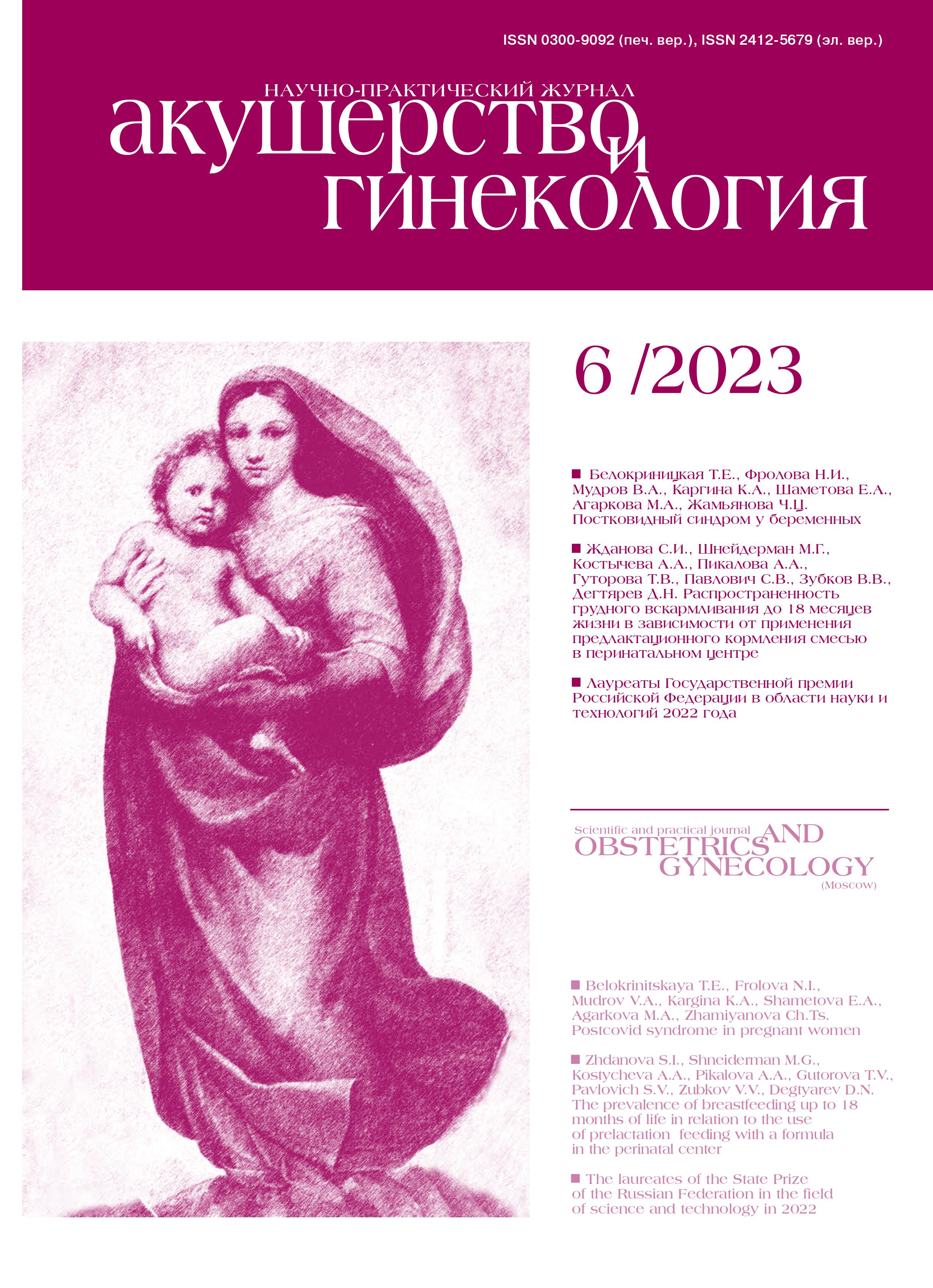A successful outcome of in vitro fertilization in absolute teratozoospermia after spermatozoon selection by the zeta potential
- Authors: Gamidova P.S.1, Makarova N.P.1, Smolnikova V.Y.1, Lobanova N.N.1
-
Affiliations:
- Academician V.I. Kulakov National Medical Research Center of Obstetrics, Gynecology, and Perinatology, Ministry of Health of Russia
- Issue: No 6 (2023)
- Pages: 155-159
- Section: Clinical Notes
- Published: 26.07.2023
- URL: https://journals.eco-vector.com/0300-9092/article/view/562916
- DOI: https://doi.org/10.18565/aig.2023.29
- ID: 562916
Cite item
Abstract
Modern sperm selection methods have not been widely applied in embryological practice, which is primarily associated with the insufficient volume of the documentary basis on their effectiveness. Sperm selection by the zeta potential is one of few methods, the clinical results of which have been published in the world literature.
Case report: This paper describes a clinical case of the in vitro fertilization protocol with sperm selection by the zeta potential in a couple with a history of few unsuccessful attempts to use assisted reproductive technologies (ART). The main cause of infertility in the couple was absolute teratozoospermia (0% of morphologically intact spermatozoa by Kruger’s strict criteria). After intracytoplasmatic injection of the sperm selected by the zeta potential into the oocytes, seven normal zygotes formed; three embryos developed; two embryos were cryo-preserved, and one embryo was transferred into the uterine cavity with the subsequent onset of pregnancy that resulted in the birth of a baby.
Conclusion: Sperm selection by the zeta potential and other studied methods for selecting male gametes deserve more active use in the ART protocols, especially in couples with repeated implantation failures. The experience gained in this way will be able to choose the most effective methods, to formulate indications for each of them, and provide a rationale their application in the context of evidence-based medicine.
Full Text
About the authors
Parvin Safail kizi Gamidova
Academician V.I. Kulakov National Medical Research Center of Obstetrics, Gynecology, and Perinatology, Ministry of Health of Russia
Author for correspondence.
Email: gamidova.parvina@yandex.ru
PhD student, Department of IVF named after Professor B.V. Leonov
Russian Federation, MoscowNatalya P. Makarova
Academician V.I. Kulakov National Medical Research Center of Obstetrics, Gynecology, and Perinatology, Ministry of Health of Russia
Email: np_makarova@oparina4.ru
Dr. Bio. Sci., Leading Researcher, Department of IVF named after Professor B.V. Leonov
Russian Federation, MoscowVeronika Yu. Smolnikova
Academician V.I. Kulakov National Medical Research Center of Obstetrics, Gynecology, and Perinatology, Ministry of Health of Russia
Email: v_smolnikova@oparina4.ru
Dr. Med. Sci., Leading Researcher, Department of IVF named after Professor B.V. Leonov
Russian Federation, MoscowNatalia N. Lobanova
Academician V.I. Kulakov National Medical Research Center of Obstetrics, Gynecology, and Perinatology, Ministry of Health of Russia
Email: n_lobanova@oparina4.ru
Junior Researcher, Department of IVF named after Professor B.V. Leonov
Russian Federation, MoscowReferences
- Palermo G.D., O’Neill C.L., Chow S., Cheung S., Parrella A., Pereira N., Rosenwaks Z. Intracytoplasmic sperm injection: state of the art in humans. Reproduction. 2017; 154(6): F93-F110. https://dx.doi.org/10.1530/ REP-17-0374.
- Tan B.K., Vandekerckhove P., Kennedy R., Keay S.D. Investigation and current management of recurrent IVF treatment failure in the UK. BJOG. 2005; 112(6): 773-80. https://dx.doi.org/10.1111/j.1471-0528.2005.00523.x.
- Avendaño C., Franchi A., Taylor S., Morshedi M., Bocca S., Oehninger S. Fragmentation of DNA in morphologically normal human spermatozoa. Fertil. Steril. 2009; 91(4): 1077-84. https://dx.doi.org/10.1016/j.fertnstert.2008.01.015.
- Гамидова П.С., Смольникова В.Ю., Макарова Н.П., Лобанова Н.Н. Методы улучшения исходов программ вспомогательных репродуктивных технологий путем инновационных подходов к селекции мужских половых клеток. Акушерство и гинекология. 2022; 7: 34-42. [Gamidova P.S., Smolnikova V.Yu., Makarova N.P., Lobanova N.N. Methods for improving the outcomes of assisted reproductive technology programs through innovative approaches to selecting male germ cells. Obstetrics and Gynecology. 2022; (7): 34-42. (in Russian)]. https://dx.doi.org/10.18565/aig.2022.7.34-42.
- Sullivan R., Frenette G., Girouard J. Epididymosomes are involved in the acquisition of new sperm proteins during epididymal transit. Asian J. Androl. 2007; 9(4): 483-91. https://dx.doi.org/10.1111/j.1745-7262.2007.00281.x.
- Simon L., Ge S.Q., Carrell D.T. Sperm selection based on electrostatic charge. Methods Mol. Biol. 2013; 927: 269-78. https://dx.doi.org/10.1007/ 978-1-62703-038-0_25.
- Said T.M., Land J.A. Effects of advanced selection methods on sperm quality and ART outcome: a systematic review. Hum. Reprod. Update. 2011; 17(6): 719-33. https://dx.doi.org/10.1093/humupd/dmr032.
- Ainsworth C., Nixon B., Aitken R.J. Development of a novel electrophoretic system for the isolation of human spermatozoa. Hum. Reprod. 2005; 20(8): 2261-70. https://dx.doi.org/10.1093/humrep/dei024.
- Nasr-Esfahani M.H., Deemeh M.R., Tavalaee M., Sekhavati M.H., Gourabi H. Zeta sperm selection improves pregnancy rate and alters sex ratio in male factor infertility patients: a double-blind, randomized clinical trial. Int. J. Fertil. Steril. 2016; 10(2): 253-60. https://dx.doi.org/10.22074/ijfs.2016.4917.
- Chan P.J., Jacobson J.D., Corselli J.U., Patton W.C. A simple zeta method for sperm selection based on membrane charge. Fertil. Steril. 2006; 85(2): 481-6. https://dx.doi.org/10.1016/j.fertnstert.2005.07.1302.
- Malvezzi H., Sharma R., Agarwal A., Abuzenadah A.M., Abu-Elmagd M. Sperm quality after density gradient centrifugation with three commercially available media: a controlled trial. Reprod. Biol. Endocrinol. 2014; 12(1): 121. https://dx.doi.org/10.1186/1477-7827-12-121.
- Takeshima T., Yumura Y., Kuroda S., Kawahara T., Uemura H., Iwasaki A. Effect of density gradient centrifugation on reactive oxygen species in human semen. Syst. Biol. Reprod. Med. 2017; 63(3): 192-8. https://dx.doi.org/10.1080/ 19396368.2017.1294214.
- Muratori M., Tarozzi N., Cambi M., Boni L., Iorio A.L., Passaro C. et al. Variation of DNA fragmentation levels during density gradient sperm selection for assisted reproduction techniques: a possible new male predictive parameter of pregnancy? Medicine (Baltimore). 2016; 95(20): e3624. https://dx.doi.org/10.1097/MD.0000000000003624.
- Shekarriz M., DeWire D.M., Thomas A.J. Jr., Agarwal A. A method of human semen centrifugation to minimize the iatrogenic sperm injuries caused by reactive oxygen species. Eur. Urol. 1995; 28(1): 31-5. https://dx.doi.org/ 10.1159/000475016.
- Baldini D., Ferri D., Baldini G.M., Lot D., Catino A., Vizziello D., Vizziello G. Sperm selection for ICSI: do we have a winner? Cells. 2021; 10(12): 3566. https://dx.doi.org/10.3390/cells10123566.
- Ionov M., Gontarek W., Bryszewska M. Zeta potential technique for analyzing semen quality. MethodsX. 2020.
Supplementary files









